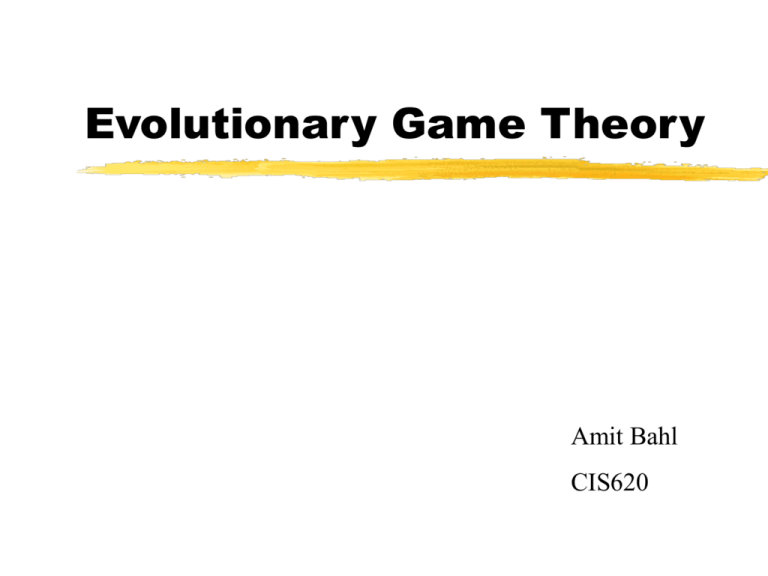Evolutionary Game Theory
advertisement

Evolutionary Game Theory
Amit Bahl
CIS620
Outline
EGT versus CGT
Evolutionary Stable Strategies
Concepts and Examples
Replicator Dynamics
Concepts and Examples
Overview of 2 papers
Selection methods, finite populations
EGT v. Conventional Game
Theory
Models used to study interactive decision
making.
Equilibrium is still at heart of the model.
Key difference is in the notion of
rationality of agents.
Agent Rationality
In GT, one assumes that agents are
perfectly rational.
In EGT, trial and error process gives
strategies that can be selected for by
some force (evolution - biological,
cultural, etc…).
This lack of rationality is the point of
departure between EGT and GT.
Evolution
When in biological sense, natural selection
is mode of evolution.
Strategies that increase Darwinian fitness
are preferable.
Frequency dependent selection.
Evolutionary Game Theory
(EGT)
Has origins in work of R.A. Fisher [The Genetic Theory of
Natural Selection (1930)].
•Fisher studied why sex ratio is approximately equal in many
species.
•Maynard Smith and Price introduce concept of an ESS [The
Logic of Animal Conflict (1973)].
•Taylor, Zeeman, Jonker (1978-1979) provide continuous
dynamics for EGT (replicator dynamics).
ESS Approach
ESS = Nash Equilibrium + Stability
Condition
Notion of stability applies only to isolated
bursts of mutations.
Selection will tend to lead to an ESS, once
at an ESS selection keeps us there.
ESS - Definition
•Consider a 2 player symmetric game with ESS given by I
with payoff matrix E.
•Let p be a small percentage of population playing mutant
strategy JI.
•Fitness given by
W(I) = W0 + (1-p)E(I,I) + pE(I,J)
W(J) = W0 + (1-p)E(J,I) + pE(J,J)
•Require that W(I) > W(J)
ESS - Definition
Standard Definition for ESS (Maynard
Smith).
I is an ESS if for all J I,
E(I,I) E(J,I) and
E(I,I) = E(J,I) E(I,J) > E(J,J)
where E is the payoff function .
ESS - Definition
Assumptions:
1) Pairwise, symmetric contests
2) Asexual inheritance
3) Infinite population
4) Complete mixing
ESS - Existence
Let G be a two-payer symmetric game
with 2 pure strategies such that
E(s1,s1) E(s2,s1) AND
E(s1,s2) E(s2,s2)
then G has an ESS.
ESS Existence
If a > c, then s1 is ESS.
If d > b, then s2 is ESS.
s1
s2
s1
a
c
s2
b
d
Otherwise, ESS given by playing s1 with
probability equal to (b-d)/[(b-d)+(a-c)].
ESS - Example 1
Consider the Hawk-Dove game with
payoff matrix
H
D
H
"-25,-25"
0,50
D
50,0
15,15
Nash equilibrium given by (7/12,5/12).
This is also an ESS.
ESS - Example 1
Bishop-Cannings Theorem:
If I is a mixed ESS with support a,b,c,…,
then E(a,I) = E(b,I) = … = E(I,I).
At a stable polymorphic state, the fitness
of Hawks and Doves must be the same.
W(H) = W(D) => The ESS given is a
stable polymorphism.
Stable Polymorphic State
ESS - Example 2
Consider the Rock-Scissors-Paper Game.
Payoff matrix is given by
R S P
R -e 1 -1
S -1 -e 1
P 1 -1 -e
Then I = (1/3,1/3,1/3) is an ESS but
stable polymorphic population
1/3R,1/3P,1/3S is not stable.
ESS - Example 3
Payoff matrix :
s1
s2
s3
s1
1,1
"-2,2"
2,-2
s2
2,-2
1,1
"-2,2"
s3
"-2,2"
2,-2
1,1
Then I = (1/3,1/3,1/3) is the unique NE,
but not an ESS since E(I,s1)=E(s1,s1)= 1.
Sex Ratios
Recall Fisher’s analysis of the sex ratio.
Why are there approximately equal
numbers of males and females in a
population?
Greatest production of offspring would be
achieved if there were many times more
females than males.
Sex Ratios
Let sex ratio be s males and (1-s)
females.
W(s,s’) = fitness of playing s in population
of s’
Fitness is the number of grandchildren
W(s,s’) = N2[(1-s) + s(1-s’)/s’]
W(s’,s’) = 2N2(1-s’)
Need s* s.t. s W(s*,s*) W(s,s*)
Dynamics Approach
Aims to study actual evolutionary process.
One Approach is Replicator Dynamics.
Replicator dynamics are a set of
deterministic difference or differential
equations.
RD - Example 1
Assumptions: Discrete time model, nonoverlapping generations.
xi(t) = proportion playing i at time t
(i,x(t)) = E(number of replacement for
agent playing i at time t)
j {xj(t) (j,x(t))} = v(x(t))
xi(t+1) = [xi(t) (i,x(t))]/ v(x(t))
RD - Example 1
Assumptions: Discrete time model, nonoverlapping generations.
xi(t+1) - xi(t) = xi(t) [(i,x(t)) - v(x(t))]
v(x(t))
RD - Example 2
Assumptions : overlapping generations,
discrete time model.
In time period of length , let fraction
give birth to agents also playing same
strategy.
j xj(t)[1 + (j,x(t))] = v(x(t))
xi(t+) = xi(t)[1 + (i,x(t))]
v(x(t))
RD - Example 2
Assumptions : overlapping generations,
discrete time model.
xi(t+) - xi(t)= xi(t)[ (i,x(t)) - v(x(t))]
1+ v(x(t))
RD - Example 3
Assumptions: Continuous time model,
overlapping generations.
Let 0, then
dxi /dt
=
xi(t)[(i,x(t)) - v(x(t))]
Stability
Let x(x0,t): S X R S be the unique
solution to the replicator dynamic.
A state x S is stationary if dx/dt = 0.
A state x is stable if it is stationary and for
every neighborhood V of x, there exists a
U V s.t. x0 U, t
x(x0,t) V.
Propostions for RD
If (x,x) is a NE, then x is a stationary
state of the RD.
dxi /dt
=
xi(t)[(i,x(t)) - v(x(t))]
What about the converse?
Consider population of all doves.
Propostions for RD
If x is a stable state of the RD, then (x,x)
is a NE .
Consider any perturbation that introduces a
better reply.
What about the converse? Consider:
s1
s2
s1
1,1
0,0
s2
0,0
0,0
Stronger notion of Stability
A state x is asymptotically stable if it is
stable and there exists a neighborhood V
of x s.t. x0 V, limt x(x0,t) = x.
ESS and RD
In general, every ESS is asymptotically
stable.
What about the converse?
ESS and RD
Consider the following game:
s1
s2
s3
s1
0,0
"-2,1"
1,1
s2
1,-2
0,0
1,4
s3
1,1
4,1
0,0
Unique NE given by x* = (1/3,1/3,1/3).
If x = (0,1/2,1/2), then
E(x,x*)=E(x*,x*)=2/3 but
E(x,x)=5/4 > 7/6=E(x*,x).
ESS and RD
s1
s2
s3
x*
x
s1
0,0
"-2,1"
1,1
s2
1,-2
0,0
1,4
x*
2/3,2/3
2/3,7/6
s3
1,1
4,1
0,0
x
7/6,2/3
5/4,5/4
In 2X2 games, x is an ESS if and only if x is
asymptotically stable.
A Game-Theoretic Investigation of
Selection Methods Used in Evolutionary Algorithms
Ficici, Melnik, Pollack
Selection Methods
How do common selection methods used
in evolutionary algorithms function in
EGT?
Dynamics and fixed points of the game.
Selection function
xi(t+1) = S(F(xi(t)),xi(t))
where S is the selection function,
F is the fitness function, and
xi(t) is the proportion of population
playing i at time t.
Fitness Dependent
Selection
f’ = (p X f)/(p • f)
{x(x0,t): t R} = orbit passing through x0.
Truncation Selection
1) Sort by
fitness
2) Replace
k% of lowest
by k% of
highest
Truncation Selection
Consider the Hawk-Dove game with ESS
given by (7/12 H, 5/12 D)
If .5 < xH(t) < 7/12, then xH(t+1) = 1.
Truncation Selection
Map Diagram:
(, )-ES Selection
Given a population of offspring, the best are chosen
to parent the next generation.
More extreme than truncation selection.
Linear Rank Selection
Agents sorted according to fitness.
Assigned new fitness values according to
their rank.
Causes fitness to change linearly with
rank.
Causes cycles around ESS.
Linear Rank Selection
Map Diagram:
Boltzman Selection
Inspired by simulated annealing.
Selection pressure slowly increased over
time to focus search.
In some cases, BS is able to retain the
dynamics and equilibria in EGT.
Boltzman Selection
Map Diagram:
Effects of Finite Populations on Evolutionary Stable
Strategies.
Ficici, Pollack
Finite Populations
Effects of finite population on EGT.
Begin at ESS (7/12,5/12) and test
n=60,120,300,600, and 900 for 2000
generations.
100 replicates of each experiment.
Finite Populations
Results:
Convergence
For a n player name, consider the MC with
states given by #of hawks.
Define transition matrix P.
bt = b0Pt
E(xH(t)) = (1/n)
ni=0 bHt * i
limt E(xH(t)) = bH
Estimate | E(xH(t)) - bH |
Convergence Simulation
Results:





